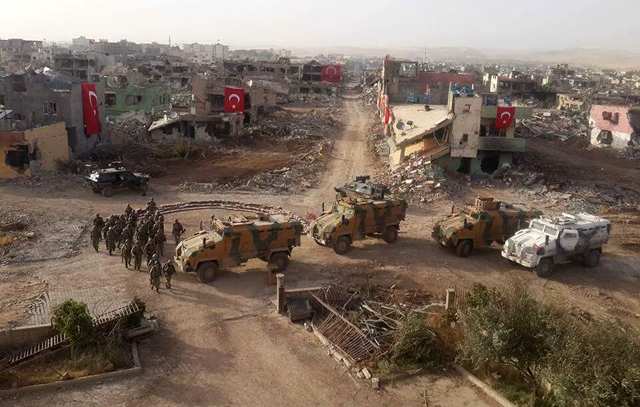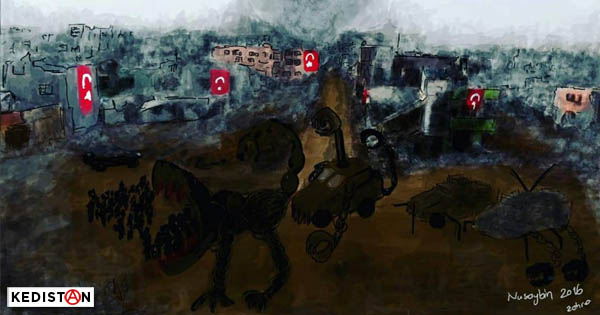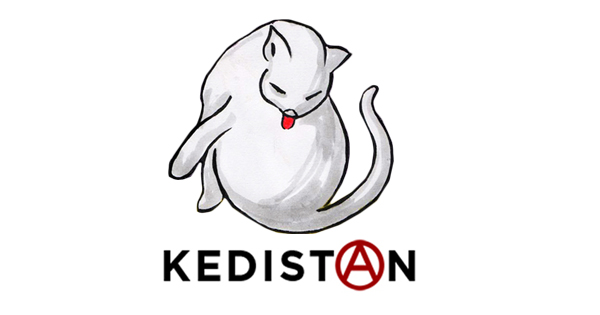Türkçe | English | Français
On the site of the newspaper Evrensel, Çağrı Sarı addresses a letter to Picasso. From Guernica to Nusaybin, the same shade of burnt tar.
Dear Picasso,
When you decided to spend three and a half hours drawing a bombed town in 1937, what color, what pains dripped from your brush? I don’t know. For example, did your tears mix into the paint? Some wounds never heal, as if what flowed from them wasn’t blood but tar… Every time a town is bombed, every time a mother takes refuge in a corner and cries over her son, this tar flows again, this may be why saying three and a half hours seems easy. A bombed, destroyed town…People dying, the cries of the mothers, the disappearance of the animals, the destruction of the houses…In Guernica, was is only the houses that turned into debris?
80 years have gone by, Picasso… A town has disappeared, bombarded for minutes, hours, by nazi planes, a newspaper titled “This morning, Guernica is no more”… Everyone fell silent…
Many are those who learned from your canvas that, in one night, thousands of people died, were wounded, a town was annihilated. While putting brushstrokes on your canvas, did you think that this work would carry on for so many years and grow so much?
What you were telling was a suffering, and this suffering has been re-experienced, always under different guises. You witnessed it before departing from this world. With each new bombing, would you have recalled Guernica? Would your wound have healed?

Ah, Picasso, now I am going to tell you about another suffering, another wound that bleeds…
The heart of Turkey bled a lot in 2015–2016 and continues to bleed tar. Bombs exploded, young people died. We were witnesses. Sometimes the bullets knew where to go, sometimes not. We continue to witness. Those who were going out to play were in the bombs’ crosshairs, as were those demanding peace, even those who wanted to bring toys to the children of war…And all those who came out of work, tired, and wanting to go home.
Did you know there were curfews in several places in Eastern Turkey last year? This went on for days, for weeks, for months… On those lands where the Kurds lived, everything has been laid to waste. So many people have died. Official sources quote figures of two thousand. They write it in letters and figures: 2 thousand. They even killed the children on those lands, even the children…
People coming out of their houses with white flags, demanding “peace” were shot down. People were killed in cellars but the worst was maybe the death of humanity… Now, the atmosphere reeks of hatred. Many organizations reported that those who burned in the cellars were crying “Water, water” but the newspapers didn’t write about it. They couldn’t! And yet, they reeked of burned human flesh, those cellars.
The buildings were destroyed. Living in them had become impossible. Hundreds set out on the road. Exodus, several, were experienced. The reports speak of 500 thousand people. Education and health? I’m talking about surviving and breathing. I’m saying there were dead bodies in the streets… For example, in Cizre, bones were found in the rubble. Mothers could not identify their daughter. The body of a women remained in the streets for weeks. People who tried to approach her were shot at.
No one wrote it, no one could write it… Apart from a few newspapers, a few internet sites. And those who wanted to write it were shot at. Some are wounded, others are in custody… or threatened.
For example, Sur, a historical town… If you had seen the architecture, the caravansaray, you would have painted such canvasses!…
Before 2015, of course… A town where civilizations passed through… Children running down narrow streets… Afterwards? Ghost… History? Who cares about it?
In the town of Nusaybin, the curfew lasted five months. Five months later, they said “we have lifted the curfew.” Despite that, people could not go out on the streets… In any event, what was left of the street… For example, Emire Gök was killed, aged 39, mother of 4 children. Her neighbours saw she had stepped out into her garden to feed the animals, then they saw her get killed. For example, Selamet Yeşilmen died, walking down the stairs of his house, with the children.
A year has gone by since all the events I’m telling you about… Institutions that call themselves official have published images. There was a photograph… Showing houses and destroyed buildings, large Turkish flags… Everywhere… What was that photo meant to say, what was it saying? What could a giant Turkish flag be saying?

What message were those flags sending, for example, to Emire’s children, the one who was shot down? Peace is so difficult, Picasso, I don’t know what Emire’s child thought in seeing this photo. For example, will he still put all his hope in peace?
All that had been lived through had to be written down, of course. Those who didn’t know had to be informed. They arrested several journalists who were attempting to inform… Zehra Doğan was one of them. They arrested her. Zehra stayed in jail for months . [141 jours]. Zehra wanted to visibly engrave into the story, not only her information but also other things. What was happening was savage, everything had to be recorded, everything. She had talent, she drew. On her canvas, there was a Nusaybin bedecked with Turkish flags…
Almost a year has gone by. Zehra has been sentenced…She shared on social networks the work where the spoke about Nusaybin. What a great crime… Apparently, when Gernica was exhibited, a Nazi soldier asked you: “You did this?”, you answered “No, you did!” Zehra gave the same answer. “They are the ones who took the photo. All I did, was simply draw.”
Guernica… Cold… Grey… Dead blue… There are no colors left in Nusaybin. What is left is the black of destruction. And how to disperse this blackness?
Years have gone by since Guernica. What has that time changed? The misery, the suffering, the war, the anger… No! Unfortunately, the landscapes of inhumanity in your work continue to exist.
But wait! In order to change this world, there is a struggle going on today, working and constantly making sketches. And this sketch will become the greatest work in the world…Perhaps they will ask again: “You did this?” And we will answer, “Yes”, Picasso, “We are the ones who did this.”
Çağrı Sarı







